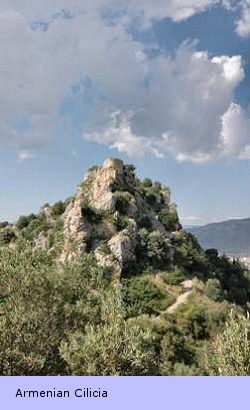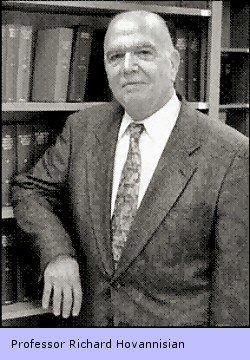|
In Search of Armenian Cilicia
 ARPA INSTITUTE
ARPA INSTITUTE
18106 Miranda St.,
Tarzana CA 91356 USA
Tel/Fax: (818) 453-0618
Vazgen Sargsyan 26/1
Yerevan, Armenia 0010
Tel: (374 10)545538 (39)
Presents: An Illustrated Lecture/Seminar on
“In Search of Armenian Cilicia”
by
Prof. Richard Hovannisian,
AEF Professor of Modern Armenian History, UCLA
Thursday, June 23, 2011 @ 7:30PM
Merdinian Auditorium: 13330 Riverside Dr. Sherman Oaks, CA 91403 USA
Directions: On the 101 FY Exit on Woodman,
Go North and Turn Right on Riverside Dr.
Abstract: After traveling through much of historic Western Armenia four years ago, Professor Hovannisian journeyed to Caesarea and Cilicia two years later, this time as historian-guide of a tour organized by NAASR. Beginning with the rock-hewn Orthodox cave churches of Cappadocia, the group traveled to Caesarea/Gesaria, Talas, Evereg-Fenese, Chomakhlu, and over the Taurus Mountains to Hadjin, Sis, Adana, Tarsus, Mersin, Selefke, Dortyol, Antioch, Musa Dagh, Killis, Aintab, Zeitun, and Marash. Scenes from these former vibrant centers of Armenian life will be shown and discussed by Professor Hovannisian.
Cilicia: During the time of the Crusaders, the Armenian Kingdom of Cilicia was established and thrived for almost three centuries. The Seljuk Turkish invasions of Armenia were followed by an exodus of Armenians migrating westward into the Byzantine Empire, and in 1080 Ruben, a relative of the last king of Ani, founded in the heart of the Cilician Taurus a small principality which gradually expanded into the Armenian Kingdom of Cilicia. This Christian state, surrounded by Muslim states hostile to its existence, had a stormy history, giving valuable support to the crusaders, and trading with the great commercial cities of Italy. Levon II, Leo the Great (r. 1187-1219)), extended the kingdom beyond the Taurus Mountains and established the capital at Sis. He assisted the crusaders, was crowned King and married one of the Lusignans of the crusader kingdom Cyprus. Hetum I (r. 1226-1270) made an alliance with the Mongols, which secured their assistance and the protection of Cilicia from the Memluks of Egypt, until the Mongols themselves converted to Islam. Levon V died in 1342, and John of Lusignan was crowned king as Gostantin IV. He and his successors alienated the native Armenians by attempting to make them conform to the Roman Church, until at last the kingdom, falling prey to internal dissensions, succumbed in 1375 to the attacks of the Egyptian Mamluks.
 Richard Hovannisian is the Professor of Armenian and Near Eastern History and Holder of the Armenian Educational Foundation Chair in Modern Armenian History at the University of California, Los Angeles (UCLA). He was born and raised in Tulare, California. He received his B.A. and M.A. in history from the University of California, Berkeley and Ph.D. in history from UCLA. A member of the UCLA faculty since 1962, he has organized both the undergraduate and graduate programs in Armenian history and has guided many students to the M.A. and Ph.D. degrees in Armenian History.
Dr. Hovannisian served as the Associate Director of UCLA’s Center for Near Eastern Studies from 1978 to 1995. He is the first Holder of the AEF Chair since 1986. From 1965 to 1969 he was also Associate Professor of History at Mount Saint Mary’s College in Los Angeles, and has served as a distinguished visiting professor at the University of California, Berkeley; California State University, Fresno; Florida Atlantic University; and Clark University. Professor Hovannisian is a Guggenheim Fellow and has received many honors for his scholarship, civic activities, and advancement of Armenian studies. He is a founder and six-time president of the Society for Armenian Studies and serves on the editorial boards of five journals and on the boards of directors of ten scholarly and civic organizations. He has given hundreds of lectures and participated in numerous international forums and in the media on Armenian issues.
Richard Hovannisian is the Professor of Armenian and Near Eastern History and Holder of the Armenian Educational Foundation Chair in Modern Armenian History at the University of California, Los Angeles (UCLA). He was born and raised in Tulare, California. He received his B.A. and M.A. in history from the University of California, Berkeley and Ph.D. in history from UCLA. A member of the UCLA faculty since 1962, he has organized both the undergraduate and graduate programs in Armenian history and has guided many students to the M.A. and Ph.D. degrees in Armenian History.
Dr. Hovannisian served as the Associate Director of UCLA’s Center for Near Eastern Studies from 1978 to 1995. He is the first Holder of the AEF Chair since 1986. From 1965 to 1969 he was also Associate Professor of History at Mount Saint Mary’s College in Los Angeles, and has served as a distinguished visiting professor at the University of California, Berkeley; California State University, Fresno; Florida Atlantic University; and Clark University. Professor Hovannisian is a Guggenheim Fellow and has received many honors for his scholarship, civic activities, and advancement of Armenian studies. He is a founder and six-time president of the Society for Armenian Studies and serves on the editorial boards of five journals and on the boards of directors of ten scholarly and civic organizations. He has given hundreds of lectures and participated in numerous international forums and in the media on Armenian issues.
Since the 1970’s, Dr. Hovannisian has focused on remembrance and denial of the Armenian Genocide, about which he has spoken in 35 countries, more than 150 colleges and universities, and more than 1000 public lectures and forums on six continents. He has served as a consultant to the California State Board of Education, authoring the chapter on the Armenian Genocide in the State’s Social Studies Model Curriculum on Human Rights and Genocide. Dr. Hovannisian has also served as a consultant to the Facing History and Ourselves Organization, assisted in the preparation of its resource book on the Armenian Genocide, and introduced the subject in numerous Facing History teacher-training institutes and summer workshops.
Dr. Hovannisian is the recipient of the Medal of Mesrop Mashtots from His Holiness Karekin II of the Great House of Cilicia in 1982, Medal of Saints Sahak and Mesrop from Catholicos of All Armenians Garegin II in 2001, and Knight of Cilicia from His Holiness Aram I in 2001. In 1990, Richard Hovannisian became the first social scientist living abroad to be elected to the Armenian National Academy of Sciences. He has received honorary doctorate degrees from Yerevan State University (1994) and Artsakh (Karabagh) State University (1997). In May 1998, on the occasion of the eightieth anniversary of the founding of the first Armenian republic, he was awarded the Movses Khorenatsi medal by the Republic of Armenia, and subsequently was awarded with a similar medal from the Republic of Mountainous Karabagh.
Dr. Hovannisian is the author of the four-volume history The Republic of Armenia and its forerunner, Armenia on the Road to Independence. He has edited and contributed to more than twenty other books, including The Armenian Image in History and Literature; The Armenian Genocide in Perspective; The Armenian Genocide; Ethics and Politics; The Armenian People from Ancient to Modern Times; Remembrance and Denial; Looking Backward, Moving Forward; The Armenian Genocide: Cultural and Ethical Legacies, and ten volumes on historic Armenian cities and provinces. The most recent, Armenian Kars and Ani (released in June), will be available for signing, along with other recent titles in the series, Armenian Constantinople and Armenian Pontus and the Black Sea Communities.
For information please contact Dr. Hagop Panossian at (818) 453-0618 or info [ a t ] ARPAInstitute.org | https://arpainstitute.org
 Armenian, Assyrian and Hellenic Genocide News
Armenian, Assyrian and Hellenic Genocide News